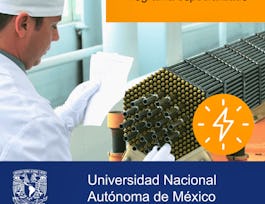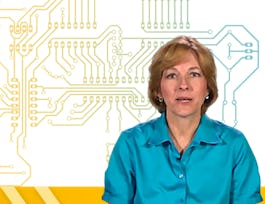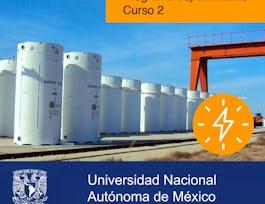The course introduces the three key spectroscopic methods used by chemists and biochemists to analyse the molecular and electronic structure of atoms and molecules. These are UV/Visible , Infra-red (IR) and Nuclear Magnetic Resonance (NMR) spectroscopies. The content is presented using short focussed and interactive screencast presentations accompanied by formative quizzes to probe understanding of the key concepts presented. Numerous exercises are provided to facilitate mastery of each topic. A unique virtual spectroscopic laboratory is made available to enable students to measure and analyse spectra online. Assessment is via summative quizzes completed during the course period.



Introduction to Molecular Spectroscopy

Instructor: Patrick J O'Malley, D.Sc
Sponsored by Barbados NTI
64,024 already enrolled
(2,542 reviews)
Skills you'll gain
- Engineering
- Data Visualization
- Design
- Graphing
- Systems Of Measurement
- Architecture and Construction
- Mechanics
- Structural Analysis
- Plot (Graphics)
- Civil Engineering
- Color Theory
- Digital Design
- Physics
- Vibrations
- Structural Engineering
- Physical Science
- Design Elements And Principles
- Building Services Engineering
- Graphic and Visual Design
- Architectural Engineering
Details to know

Add to your LinkedIn profile
7 assignments
See how employees at top companies are mastering in-demand skills


Earn a career certificate
Add this credential to your LinkedIn profile, resume, or CV
Share it on social media and in your performance review

There are 4 modules in this course
In this first week we introduce the electromagnetic spectrum and the origin of transitions giving rise to ultraviolet and visible (UV/Vis) spectra. You will learn that electronic transitions are caused by absorption of radiation in the UV/Vis region of the electromagnetic spectrum. The reason for the wavelength and intensity of bands will be described and the colour origin of certain compounds will be discussed. You will also be shown how UV/Vis spectroscopy is performed and you will be able to run and analyse your own spectra. As the final activity in this module you are given a link to view how to obtain a UV/Visible spectrum in the laboratory. Good luck, try and participate in the discussion forums to enhance your learning and don't forget to complete the end of week laboratory quiz which contributes to your final mark.
What's included
10 videos7 readings2 assignments
In this module we introduce the theory underpinning infrared (IR) spectroscopy and show examples of analysis using the technique. Transitions between the vibrational energy levels of molecules occurs in the infrared region of the electromagnetic spectrum. We start with the theory underlying vibration using the simple harmonic oscillator model. Analysis of more complex molecules is introduced using group frequencies and number of vibrational modes. You will also be shown how to obtain an infrared spectrum and will have an opportunity to run your own spectrum. At the end of this module you are given a link to view how to obtain an infra red spectrum in the laboratory. Don't forget to complete the end of week laboratory quiz which contributes to your final mark for this course.
What's included
6 videos4 readings2 assignments
This week we concentrate on Nuclear Magnetic Resonance (NMR) spectroscopy. Here a magnetic field is used to create energy levels for magnetic nuclei present in a molecule. Transition between these energy levels occurs in the radiofrequency region of the electromagnetic spectrum. The positions of the bands in the observed spectrum is dependent on the shielding of the nuclei by the local electronic structure, giving rise to a parameter known as chemical shift. Bands also display fine structure caused by spin-spin coupling with neighbouring nuclei. Examples on the analysis of NMR spectra for structure determination will be given. As the final activity in this module you are given a link to view how to obtain an NMR spectrum in the laboratory. Don't forget to compete this end of week laboratory quiz which contributes to your final mark.
What's included
9 videos4 readings2 assignments
What's included
1 assignment
Instructor

Offered by
Why people choose Coursera for their career




Learner reviews
2,542 reviews
- 5 stars
76.57%
- 4 stars
18.67%
- 3 stars
3.69%
- 2 stars
0.74%
- 1 star
0.31%
Showing 3 of 2542
Reviewed on Oct 25, 2017
Some of the questions had wrong answers in the system and hence the actual marks shown is not reflective of the exam. Please see to it that the system has correct answers.
Reviewed on May 19, 2021
it was very useful for the people who are new to this topic. but they do have to include some more small topics like red shift blue shift and emphasis more on the spectral bands.
Reviewed on Oct 14, 2020
This course helped me to further understand the principle behinds the 3 main spectroscopic techniques: UV/VIS, IR and NMR which is very beneficial for my future career working in a lab environment.
Recommended if you're interested in Physical Science and Engineering

Johns Hopkins University

Universidad Nacional Autónoma de México

Georgia Institute of Technology

Universidad Nacional Autónoma de México

Open new doors with Coursera Plus
Unlimited access to 10,000+ world-class courses, hands-on projects, and job-ready certificate programs - all included in your subscription
Advance your career with an online degree
Earn a degree from world-class universities - 100% online
Join over 3,400 global companies that choose Coursera for Business
Upskill your employees to excel in the digital economy


